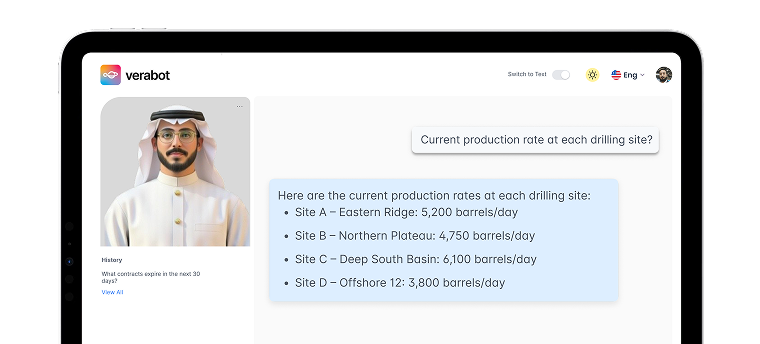Mining Technology Solutions
Toward a Safer, Smarter, and Cleaner Mining Industry
Helping the mining industry to evolve rapidly toward a more sustainable future. By investing in a smarter workforce, resilient supply chain, and cleaner operations.
Overcoming the Biggest Challenges of Mining Industry
Higher CAPEX / OPEX
- Long Engineering Cycles, Delayed Handoff to Ops
- Delayed and Over-budget Projects Deliveries
- Higher Production Downtime and Inspection Costs
Weakened Value Chain and Productivity
- Unbalanced Supply and Demand Planning
- Impaired Forecasts and Tracking from Pit to Port
- Poor Overall Equipment Effectiveness (OEE)
Constrained Workforce
- Weakened Collaboration with Remote Operations
- Impeded Workforce Efficiency without Data Insights
- Lack of Situational Awareness and Safety Procedures
Resetting Mining Industry Toward a Sustainable Future
- Predictive Maintenance
- Optimizing Production and Scheduling
Predictive Maintenance
Key Benefits
Enhanced mining equipment reliability
Minimized operational downtime and inspection costs
Optimized maintenance scheduling
Prevents unforeseen equipment failures
Technical Capabilities
Real-Time Mining Analytics
Monitor and manage multiple mines and overall equipment efficiency (OEE) with the assistance of the Internet of Things (IoT) and sensor data.
Mining Processes Management
Execute flexible mining and extraction processes and collaborate seamlessly in an integrated environment.
Predictive Maintenance Trends
Predictive maintenance for mobile equipment ranks sixth globally in terms of the overall degree to which mines have invested in it.
When properly implemented, predictive maintenance maximizes profits by minimizing the risk of losses due to system failure.
The global predictive maintenance market, which was valued at 4.5 billion US dollars in 2020, is projected to reach the size of 64.3 billion US dollars by 2030.
Transitioning from preventive to predictive maintenance can enhance a mining company's overall equipment effectiveness (OEE) from 50-75%.
Predictive maintenance can reduce maintenance planning time in mining and metal operations by 20-50% and overall maintenance costs as well.
A typical mining operation spends 35-50 percent of its annual operations budget merely on asset maintenance and repairs.
Optimizing Production and Scheduling
The mining industry is a dynamic sector with intricate operations and production. With escalating costs for maintenance, transport, machinery, workforce, and other resources; shifting environmental regulations; fluctuating market demand; managing resources such as water and energy; ensuring safe procedures; enhancing sustainability initiatives; minimizing waste generation; improving process efficiency and throughput optimization, it’s crucial for the industry to utilize data-driven solutions.
Key Benefits
Effectively manage open-pit and underground operations
Integrated cross-functional data streams
Optimized mineral extraction
Improved profitability
Technical Capabilities
Optimizing Mining Operations with AI and Data
Data analysis through AI allows operators to make more informed decisions on when to commence an excavation or kick-start an operation that may significantly impact profits – by analyzing various factors such as geological conditions, equipment status, or personnel availability. AI can also be used to assess risk before work starts by conducting predictive maintenance on machinery or predicting potential failures based on historical incidents.
Optimizing Production and Scheduling Trends
Optimizing operations and scheduling in the mining industry can lead to a 2-5% increase in extraction efficiency.
Over half (58%) of mining companies use advanced analytics for production optimization.
The market for production optimization solutions in the mining industry is projected to reach approximately $8.5 billion by the end of 2023.
Digital technologies can reduce operating costs by up to 20% in open-pit operations and up to 30% in underground operations.
- Employee Health & Safety
- Process and Workflow Automation
Employee Health & Safety
Utilize the potency of IoT sensors and AI to gain end-to-end mining process flow analytics to supervise safety standards and violations in real time. Employ predictive analytics across the mine and processing sites to optimize workflows and minimize waste. AI ensures the avoidance of production downtime due to safety violations and personnel injury on the mining site.
Key Benefits
Enhanced worker satisfaction & productivity
Ensure regulatory compliance such as OSHA & MSHA
Technical Capabilities
Real-time OEE for Safety
Track and oversee multiple mining sites and overall equipment effectiveness (OEE) with the help of the Internet of Things (IoT) and sensor data to ensure optimal operations and miners' safety.
Spatial Analysis
Using computer vision, spatial analysis infers worker safety across the mining site using video feed from the IoT-enabled edge.
ML-based Disaster Prevention
Continually monitor safety levels in a mine or sense potentially hazardous situations such as rock falls or flooding in order to mitigate potential disasters.
Employee Health & Safety Trends
According to the CDC, in all the US industries combined, the fatality rate in the mining sector is 7.25 times higher.
The global market for digital solutions in mining is projected to reach $8.7 billion by 2025, growing at a CAGR of 8.7% from 2020.
46% of mining companies already use or plan to use wearable technology in the workplace.
Companies that prioritize worker health and safety outperform their peers in terms of financial performance, with a 20% higher return on investment and a 2.2% higher return on assets.
Digital technologies can reduce accidents by up to 20% and improve productivity by up to 15%.
Process and Workflow Automation
Leverage critical data for insightful & forward-thinking business decisions through AI. Utilize data and AI to digitally mirror intricate mining systems in near real-time and improve efficiency.
Key Benefits
Boosted productivity
Prompt and actionable information
Economically efficient operations
Technical Capability
Form Recognizer
Convert extensive volumes of records into useful data, digitize unstructured documents, including handwritten notes, and surpass traditional OCR to categorize document types and extract field names and values.
Process and Workflow Automation Trends
55% of mining companies have adopted process automation technologies.
Automating workflows can reduce mining costs by up to 15% and increase production by up to 25%.
The process automation market in mining is projected to reach $15.2B by 2025.
- Supply Chain & Logistics Optimization
- Real-time Asset Tracking
Supply Chain & Logistics Optimization
Delivering a smart supply chain to anticipate market demands and detect changes in supply and demand. Intelligent connected supply chain to launch a range of highly personalized add-on services and gain insights about market needs based on trends, signals, and behavior patterns. Drive new growth with modern data estate, analytics, and AI by delivering exceptional operational experiences.
Key Benefits
Improved order fulfillment and promising
Efficient raw material sourcing and logistics
Sustainable load optimization
Enhanced logistics (tracking & traceability)
Better supply chain visibility
Reduced transportation costs
Technical Capabilities
AI/ML-based Inventory Management
Boost business resilience by quickly responding to disruptions and intelligently selecting alternatives for supply shortages.
Intelligent & Connected Demand Planning
Respond to changing market demand with machine learning, connected processes, and increased visibility across sales and operations planning (S&OP), forecasting, supply, replenishment, and inventory functions.
Real-time Orders and Shipments Tracking
Optimize logistics processes with visibility into minerals in transit, notify stakeholders about deviations, and monitor fulfillment.
Supply Chain & Logistics Optimization Trends
The global mining market has shown significant growth, expanding from $2022.6 billion in 2022 to $2145.15 billion in 2023 at a CAGR of 6.1%.
The mining industry spends an average of 10-15% of its operating costs on logistics.
The global mining market is expected to grow at a CAGR of 6.7% from 2023 to 2027.
Optimizing logistics can reduce mining costs by up to 5%.
Real-time Asset Tracking
Harness the power of data and AI to boost the efficiency and reliability of your assets-tracking system. Gain real-time insights into assets utilization, movement, and behavior using geolocation, RFID, and IoT sensors. We simplify the process of accessing key metrics and critical information to ensure secure and optimized operation.
Key Benefits
Real-time location tracking for optimized delivery schedules minimized inventory loss and theft
Mining equipment monitoring through real-time critical indicators such as equipment temperatures, vibrations, etc., to better predict machine downtime
IoT-enabled mine management to monitor mine parameters such as humidity, temperature, and pressure to prevent inventory damages
Technical Capability
Real-time Assets and Shipments Tracking
Enhance logistics processes with visibility into assets in transit, notify stakeholders about deviations, and monitor fulfillment while keeping an eye on equipment and inventories to prevent any loss of stock and machinery.
Real-time Asset Tracking Trends
The use of Internet of Things (IoT), artificial intelligence (AI), and big data analytics can reduce logistical costs in the mining industry by up to 15%.
IoT-connected equipment can help to reduce equipment downtime by up to 20%.
Optimizing supply chain and logistics processes can improve operational efficiency in the mining industry by up to 25%.
AI-powered maintenance scheduling can help to reduce maintenance costs by up to 30%.
Industry Scenarios
Generating Business Value Across Industries
Enterprise solutions that provide real-time, actionable insights.
This solution allows COOs to look after their equipment effectively, use sensor data and analytics, closely monitor their equipment performance in real-time, and predict when maintenance is needed. The cloud can fast-process vast volumes of data to extract real-time insights, leading to cost-effective and efficient operations.
This solution helps companies assess their capacity, requirements, and demand and build accurate reservoir models, eventually leading to optimized production and better recovery rates. These models function by incorporating data gathered from multiple sources, such as seismic imaging, historical production data, sensors, and more.
This solution enables mining companies to dive deep into their data and gain insights regarding their supply chains, allowing them to identify inefficiencies and anomalies and capitalize on opportunities for process optimization. Using the cloud, real-time collaboration, and sharing data among stakeholders make supply chain operations more effective, resulting in better yield.
Through the cloud's real-time processing, organizations can monitor any external environmental factors, such as air and water quality, enabling them to be aware of any potentially harmful impacts. This also helps companies ensure their workforce's safety, avoiding any hazardous operations that may result in a catastrophe.
This solution helps CXOs gather and analyze data from various sources. The seismic imaging data, geological surveys, historical product data, and other sensor data can be processed through cloud analytics tools to help mining exploration companies to be more specific with their exploration and production planning, reducing risks and improving overall efficiency, leading to ideal results.
See How Organizations Are Innovating





We’re taking advantage of the Azure Databricks shared environment—we’ve made it our preferred collaboration platform, and it’s helping our data scientists and engineers share more and get to the next level of AI sophistication.
Situation
Safety is at the heart of everything Shell does. From exploration to extraction and all the way to retail vending, Shell prioritizes the safety of its employees, contractors, partners and customers, and the environment.
Solution
Shell is piloting a new cloud-based, deep learning solution built on Microsoft Azure. Using closed-circuit camera footage and IoT technology to automatically identify safety hazards and alert service champions so they can quickly respond and eliminate potential problems.
Impact
Using machine vision technology, combined with automated image processing and analysis, VADR (Video Analytics for Downstream Retail) adds an extra level of safety for people and the environment.

From Guesswork to Precision: How a Self-Learning Model Transformed Supplier Management
Situation
In order to meet the client’s needs, a comprehensive Well Performance System was inevitable. This digitalization and automation of plant processes were necessary to increase efficiency by replacing manual and traditional methods of collecting data. Through this approach, the company could see better performance across its operations.
Solution
The Well Performance System we developed was tailored to the needs of the enterprise, enabling it to collect data from vendor devices and sensors, visualize operational data, and deliver analytics so decision-makers could make informed decisions that would lead to improved performance and cost reduction.
Impact
The implementation of the Well Performance System had a significant impact on the enterprise’s operations. It increased production, provided real-time well status, enabled proactive maintenance and alerts, and ultimately improved Overall Equipment Effectiveness (OEE).
This improved the Business Development team’s decision-making abilities and reduced lost opportunity due to supplier churn. The self-learning ensemble model provided more accurate predictions, allowing the team to make better decisions regarding supplier management and category sales.

Benefitting from the Cloud to Streamline Production Processes and Decision Making
Situation
Solution
Impact
- Multi-well performance characterization and optimization
- Significant improvements in uptime and efficiency
- Realtime equipment diagnostics and prognostics

Shedding Redundant Methods to Implement New and Improved knowledge Management Procedures
Situation
Solution
Impact
- Created an environment that maximizes knowledge creation, sharing, capture, and collaboration
- Enhanced information structure and accessibility throughout the entire knowledge management life cycle
- Supports approval and validation processes for structured knowledge
















